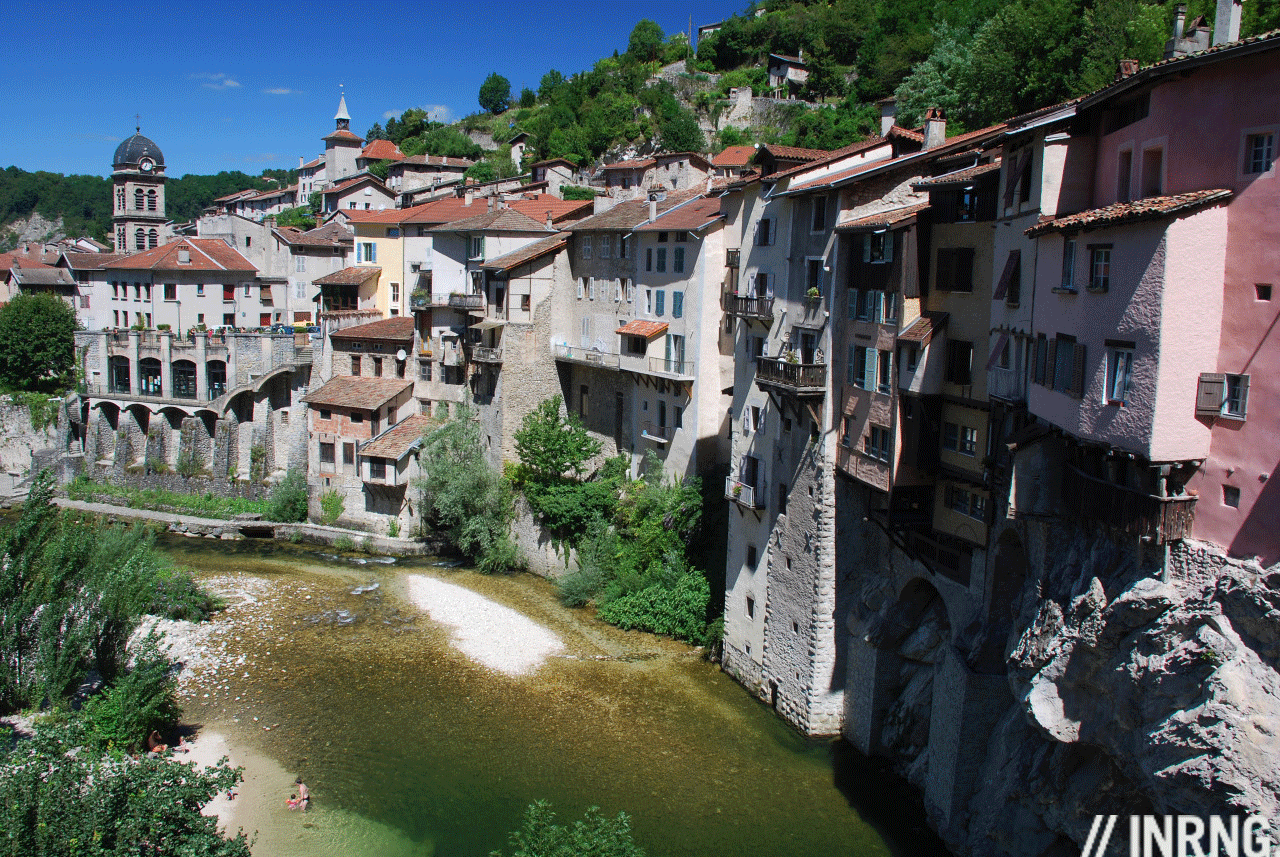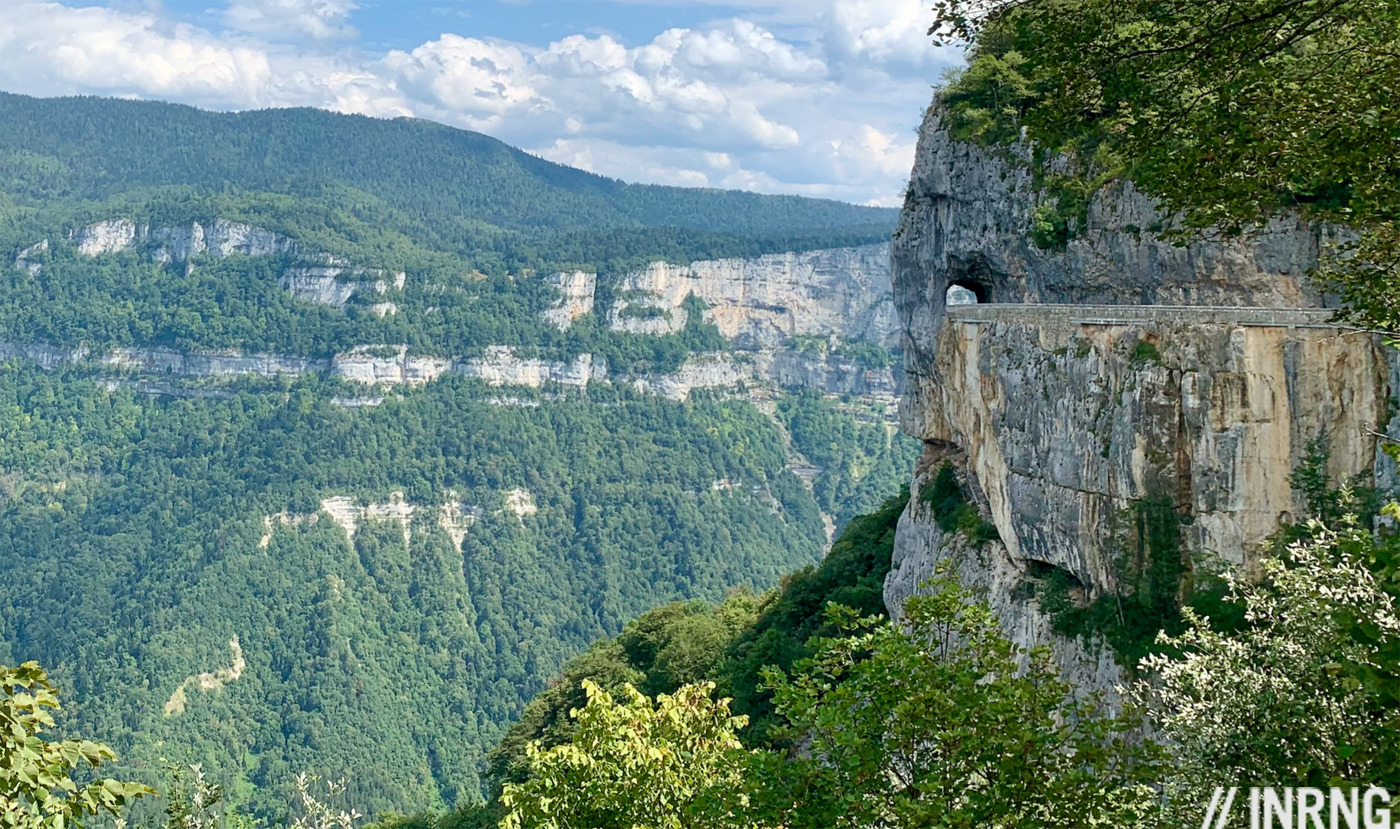The Critérium du Dauphiné heads for the Vercors, a high plateau surrounded by precipitous cliffs. The race takes the Col du Rousset, an impressive road but other approach roads are even more stunning. The Combe Laval is famous for its vertigo-inducing cliffhanger section, a narrow road cut into the cliff with a terrifying drop off the side. But is it France’s most overrated road?
 The Route: the D76 starts in St Jean en Royans in the Isère department in French Alps. Climbing to the Col de Gaudissart the road is 7.8km long and climbs at 8% with the Combe Laval section near the top.
The Route: the D76 starts in St Jean en Royans in the Isère department in French Alps. Climbing to the Col de Gaudissart the road is 7.8km long and climbs at 8% with the Combe Laval section near the top.

The Feel: the Royans area below the Vercors plateau is pleasant enough with thousands of walnut trees arranged in rows for local farms. It’s almost a piece of Italy in France with the pastel-toned buildings, especially Pont-en-Royans.
The plateau is high above and an obvious destination. The climb is easy to find with “col” signs signalling if the road is open. Business begins early with a firm slope and a rough, rasping road that’s like riding up a cat’s tongue and almost old-fashioned, the kind they used to have everywhere but you only find on old back roads.

You ride quickly into woodland. Do it in the morning and there’s shade from the canopy and plenty of cool as this is on the western flank of the plateau; it means ice in the winter. There’s a fountain in the woodland on the way up if it’s hot, in fact there are two and the second is superior in every sense. This woodland isn’t what was expected, all the images of the Combe Laval show a road cut into the cliff with expansive views below. Onwards and it drags up through the woodland, still no cliff road, but scenic with glimpses of the Isère valley below and little traffic to note. There are signs for cyclists every kilometre telling of the slope ahead but as for the distance, it’s for the Col de la Machine which is beyond the Combe Laval flat section to come so you can subtract several kilometres from the distance to go. The road rounds a bend as it leaves the woodland and soon there’s a sign for the Col de l’Echarasson (“Ladder Pass” in local dialect), ignore the temptation to try this and press on, round the corner of the unmarked Col de Gaudissart by the telecoms masts.

The first thing you’ll see of the Combe Laval is the parked cars as tourists stop for the view. Now all that climbing is rewarded with a view of the valley below, a straight drop below. Continue and you get the cliffhanger road section, passing through sections of road cut in the edge of the cliff including some short tunnels. It is stunning but suddenly that’s it, soon aftrer the road climbs up through a tunnel and passes a café and lodge and the famous bit of road is over. Now you’re on the Vercors plateau.
The Vercors: once on the plateau there’s plenty to see and do for the cyclist with a range of roads and many mountain passes to cover. There are too many routes to list but something for everyone.
France’s most overrated road? The internet buzzes with excited talk and breathtaking photos, anxious tourists regularly ask if the Combe Laval is safe, do they risk plummeting 600 metres into the ravine below? Of course this is France, not Ladakh and it’s totally safe, the road is secure.
The famous section of the Combe Laval road is celebrated for a reason given the vertical drop off the side, the history behind the road’s construction and, above all, because it is very photogenic. But for the cyclist there’s a long climb just to get to this notorious part which makes the cliff-edge experience short, the famous part is a couple of kilometres long and you need to stop and peer over the parapet to take in the best views. It’s like sitting through a long speech just to wait for one punchline, or playing a whole album just for a few bars of one song. Now some things are worth waiting for and the rest of the road is scenic and rewarding in a way, it’s just that all the talk about this climb is reserved for a very short section of road. Most of the climb is through woodland and offers no views.
This is a popular route up to the plateau for motorists and motorcyclists as the main climb has long straight ramps. Cyclists have more choice. There are many more scenic ways to climb up the Vercors plateau, many with sections cut into the cliffs. Try the Col de Romeyère from St Gervais to the north of St Jean de Royans for cliff edge roads cut into the rocks, better views of the Isère valley below and less traffic. There’s the Tunnel des Ecouges that’s pitch black, you need a light, not for safety but primarily to see where you’re going otherwise you’ll be walking up and feeling the route with your hands. Seriously, it’s that dark and if you take a light, it needs to be a bright one, a flashing LED or your phone’s torch feature won’t cut it. But they’re doing works and lighting could be on the way.
History: the Vercors is famous to many in France as a battlefield for the French resistance during WW2 and with good reason: the terrain is awkward and inaccessible. Before the war it was exploited for woodland but the lumberjacks had a problem: they could cut down plenty of trees but they could not get them off the plateau. So they built several roads and had to cut these into the cliff, including the Combe Laval section. They did this by abseiling down the cliffs, digging small holes in the rock and putting TNT inside and, once the fuse was lit, merrily swinging to the side to avoid the blast. The result is stunning balcony roads, never has deforestation been so good for cycling.
In cycling history Villard de Lans was been a regular destination of the Tour de France in the 1980s and early 1990s where it was used as often for a time trial arrival as a normal stage. It’s used the current Dauphiné finish of Côte 2000 before where Pedro Delgado, Laurent Fignon and Eric Breukink won.
Travel and access: the Vercors plateau sits above the Alpine city of Grenoble. It has a fine location and is well-connected by road and rail but the city is a mixed place with a few quartiers for the tourist to avoid. It’s still a pleasant university town surrounded by the mountains and some high tech industries.
It’s also just 50km from the foot of Alpe d’Huez. If you visit the Alps for The Alpe then you always run the risk of some boring roads. Once you’ve climbed the Alpe, done the Galibier, the Glandon, the Villard Reculas balcony road, the Col d’Ornon and the Col de Sarenne you risk repeating same roads. A visit to the Vercors is worth the effort as the terrain is so different.
More roads to ride at inrng.com/roads


Bit harsh. It’s a nice climb and the cliff section is jaw-dropping if you’ve not ridden it before.
It’s well worth a ride and makes an entertaining shortish loop if you come back down through La Chapelle and Choranches.
Thank you for this post, I plan to spend a week at Grenoble in August. I know it’s going to be crowded & expensive but I managed to get a university visit 🙂
On the contrary, Grenoble becomes quiet from Bastille Day onwards and there are plenty of quiet roads to explore
For another stunning road up to the plateau cut into the cliff, try the Col du Mont Noir from the Cognin-les-Gorges side. I agree with INRNG that the Combe Laval’s scenic section is short, but it is spectacular. There are lots of other fantastic little cliff roads in the Vercors, such as the Gorges de la Bourne, which is currently closed but which I rode some years ago. Another one is the Col de Toutes Aures (not the same as the one in the Alpes de Haute Provence) from Presles down to Pont-en-Royans. Love the Vercors.
Thanks for the heads up on the Vercours. I can feel a road trip coming on 🙂
I camped in the Vercors (Autrans). It is lovely with some beautiful roads to cycle. It does rain a bit though.
I lived in Grenoble for a few months in my (very) amateur days and the Vercours would make up the bulk of our training rides, much more pleasant, and quicker, to ride to than the big Alps to the east and quiet roads for the most part.
If you’re feeling adventurous the 3km road up to the Bastille contains a few metres at 30% affords a brilliant view of the city to the south and west.